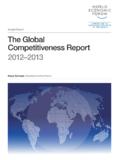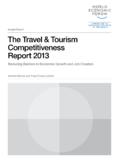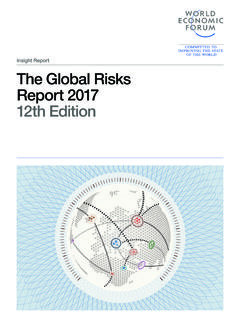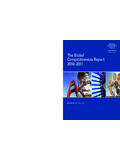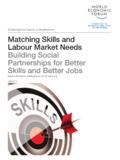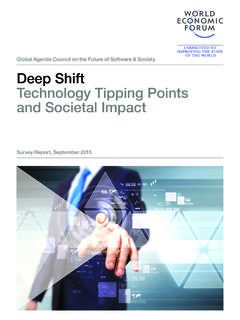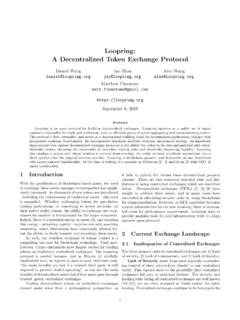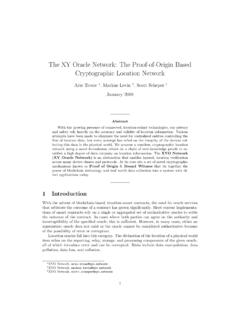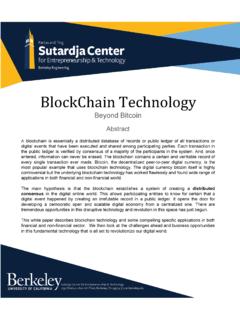Transcription of Decentralized Finance (DeFi) Policy-Maker Toolkit
1 Decentralized Finance (DeFi) Policy-Maker ToolkitWHITE PAPERJUNE 2021In collaboration with the Wharton Blockchain and Digital Asset ProjectContentsForewordExecutive summary1 What is DeFi? Distinguishing characteristics The DeFi DeFi service categories2 Risks Financial Legal Emergent risks3 Policy DeFi and financial Available policy Decision treeConclusionAppendix 1: Background assessmentAppendix 2: Stakeholder mapping toolAppendix 3: Decentralization spectrumAppendix 4: DeFi Policy-Maker canvasContributors AcknowledgementsEndnotes3456710121415161 818202122242526283031343536 Cover: Gradienta, Unsplash Inside: Getty Images, Unsplash 2021 World Economic Forum. All rights reserved. No part of this publication may be reproduced or transmitted in any form or by any means, including photocopying and recording, or by any information storage and retrieval Finance (DeFi) Policy-Maker Toolkit2 ForewordDecentralized Finance (DeFi) is an emerging and rapidly evolving area in the blockchain environment.
2 Although examples of DeFi have existed for several years, there was a sudden upsurge of activity in 2020. In one year, the value of digital assets1 locked in DeFi smart contracts grew by a factor of 18, from $670 million to $13 billion; the number of associated user wallets grew by a factor of 11, from 100,000 to million; and the number of DeFi-related applications grew from 8 to more than This growth in turn has stimulated interest from both the private and public sectors. DeFi aims to reconstruct and reimagine financial services on the foundations of distributed ledger technology, digital assets and smart contracts. As such, DeFi is a noteworthy sector of financial technology (fintech) , serious questions remain: What, if any, are the distinctive aspects of DeFi? What distinguishes a DeFi service from a similar service based on traditional Finance ? What are the opportunities and potential benefits of DeFi? To whom will these benefits accrue and who might be excluded or left behind?
3 What are the risks individual, organizational and systemic of using DeFi? How do these risks apply to clients, markets, counterparties and beyond? Can DeFi become a significant alternative to traditional financial services? If so, will there be points of integration? If not, what if anything will DeFi represent in the market? What novel legal and policy questions does DeFi raise? How should policy-makers approach DeFi? What options exist for addressing these questions?Notably, the DeFi space is relatively nascent and rapidly evolving, so the full scope of risks and potential for innovation remain to be seen and there are unique challenges in regulating and creating policies for such a new and changing area. This report does not recommend any one single approach; instead, it is designed as a set of tools that can be applied in light of the legal contexts and policy positions of each jurisdiction, which may vary. In the appendices we offer a series of worksheets and other tools to assist with the evaluation of DeFi activities.
4 A companion piece, DeFi Beyond the Hype, provides additional detail about the major DeFi service hope is that this resource will enable regulators and policy-makers to develop thoughtful approaches to DeFi, while helping industry participants understand and appreciate public-sector concerns. It is the result of an international collaboration among academics, legal practitioners, DeFi entrepreneurs, technologists and regulatory experts. It provides a solid foundation for understanding the major factors that should drive policy-making Finance (DeFi) Policy-Maker ToolkitJune 2021 Sumedha Deshmukh Platform Curator, Blockchain and Digital Assets, World Economic ForumSheila Warren Deputy Head, Centre for the Fourth Industrial Revolution; Member of the Executive Committee, World Economic ForumKevin Werbach Professor of Legal Studies & Business Ethics, and Director, Blockchain and Digital Asset Project, Wharton School, University of PennsylvaniaDecentralized Finance (DeFi) Policy-Maker Toolkit3 Executive summaryDecentralized Finance ( DeFi ) is a broad term for financial services that build on top of the Decentralized foundations of blockchain technology.
5 The space has evolved since the 2015 launch of the Ethereum network , which laid the groundwork by implementing blockchain-based smart There has been increased interest recently, paralleling the 2013 spike in bitcoin price and the 2017 boom in initial coin As new DeFi services aspire to reinvent elements of financial services, and billions of dollars of digital assets are pledged to DeFi capital pools, policy-makers and regulators face significant challenges in balancing its risks and proponents say it can address challenges within the traditional financial ,6 Open-source technology, economic rewards, programmable smart contracts and Decentralized governance might offer greater efficiencies, opportunities for inclusion, rapid innovation and entirely new financial service On the other hand, DeFi raises considerations related to consumer protection, loss of funds, governance complexities, technical risk and systemic risk. Significant incidents involving technical failures and attacks on DeFi services have already Moreover, questions remain about the actual extent of decentralization of some protocols and associated risks, for manipulation and whether DeFi is more than a risky new vehicle for speculation that may open the door to fraud and illicit purpose of this document is to highlight DeFi s distinguishing characteristics and opportunities while also calling attention to new and existing risks including the scope, significance and challenges of the fast-growing DeFi ecosystem.
6 Understanding DeFi business models and the full set of relationships underlying DeFi is crucial for an accurate risk assessment and nuanced policy-making. This Toolkit : Provides an overview of the DeFi space generally, and the major classes of DeFi protocols, with tools to help understand the implications of new services Explores the potential benefits of the DeFi approach, along with the challenges that DeFi businesses will face Offers a detailed breakdown of the risks that DeFi may pose. Many of these are familiar concerns (although sometimes manifested differently), while others are unique to the Decentralized , programmable and composable structure of DeFi Maps out potential legal and regulatory responses to DeFiOur goal is not to recommend any specific actions universally, but to identify potential approaches and important considerations for the DeFi context. Financial regulatory regimes vary from jurisdiction to jurisdiction, as do policy-makers judgements about the relative risks and rewards.
7 DeFi will raise further questions about whether regulators have the proper tools to address evolving market activity, and how they can assert jurisdiction over a set of technologies and stakeholders that is intrinsically borderless and global. Appendix 1 offers a background assessment for policy-makers and regulators looking to understand whether DeFi may be relevant to their entity. Appendix 2 provides a stakeholder mapping tool for DeFi services. Appendix 3 outlines the decentralization spectrum, while Appendix 4 provides a DeFi Policy-Maker Finance (DeFi) Policy-Maker Toolkit4 What is DeFi?1 Decentralized Finance (DeFi) Policy-Maker Toolkit5 DeFi is a general term for an evolving trend. Broadly, it is a category of blockchain-based Decentralized applications (DApps) for financial services. DeFi encompasses a variety of technologies, business models and organizational structures,10 generally replacing traditional forms of intermediation. DeFi transactions involve digital assets and generally operate on top of base-layer settlement platforms.
8 DeFi protocols define software specifications and interfaces to create, manage and convert digital assets, building on a blockchain settlement layer. DeFi services implement DeFi protocols to create financial services, and associated functions such as specification of risk parameters and interest DeFi users access DeFi services to transact. DeFi services may be made available to users through centralized web applications or permissionless interfaces such as programmable wallets or smart contracts. They may be provided by a traditional controlling entity, a community around a non-profit entity or a Decentralized autonomous organization (DAO), in which rights and obligations are specified in smart the space is evolving quickly, we offer a functional description to distinguish DeFi from traditional financial services and auxiliary services. A DeFi protocol, service or business model has the following four characteristics:1. Financial services or products2.
9 Trust-minimized operation and settlement3. Non-custodial design4. Programmable, open and composable architectureImportantly, these characteristics represent the aspirations for DeFi. Businesses will exhibit each of these characteristics to varying degrees, and this may be fluid over projects Broadly speaking, the goal of DeFi solutions is to provide functions analogous to, and potentially beyond, those offered by traditional financial service providers, without reliance on central intermediaries or 1 provides a flow chart for evaluating whether an offering should be classified as fifl fifl fifl fifl fifl fifl fifl fifl fifl fifl fifl fifl fifl fifl fifl fifl fifl fifl fifl fifl FigureData pointDeFi classification flow chartFIGURE 1 Traditional Finance ( banking)LIKELY A DEFI SERVICEA uxiliary ( price oracles) or non-financial ( distributed storage) serviceCustodial service ( fiat-backed stablecoins)Private service or standalone digital assetnonononoDirectlymediates thetransfer of value?
10 Settlementon a publicblockchain?Assets cannotbe unilaterallyexpropriated/moved bythird parties? Open-sourcecode andapplicationprogramminginterface (API)?yesyesyesyes1. Financial services or products means processing or directly enabling the transfer of value among parties. They are distinguished from information services, such as price feeds or storage, that only indirectly support value transfer. 2. Trust-minimized operation and settlement means that transactions are executed and recorded according to the explicit logic of a DeFi protocol s predetermined rules, on a permissionless basis. That is, due to their availability through a Decentralized settlement layer, transactions do not require trust in the counterparty or a third-party intermediary. While the platforms vary, DeFi projects generally build on public, permissionless To date, most activity has been on the Ethereum blockchain, but activity is growing on other networks such as Algorand, Avalanche, Binance Smart Chain, Cosmos, EOS, NEAR, Polkadot, Solana and Service functionality is defined by a set of smart contracts.
